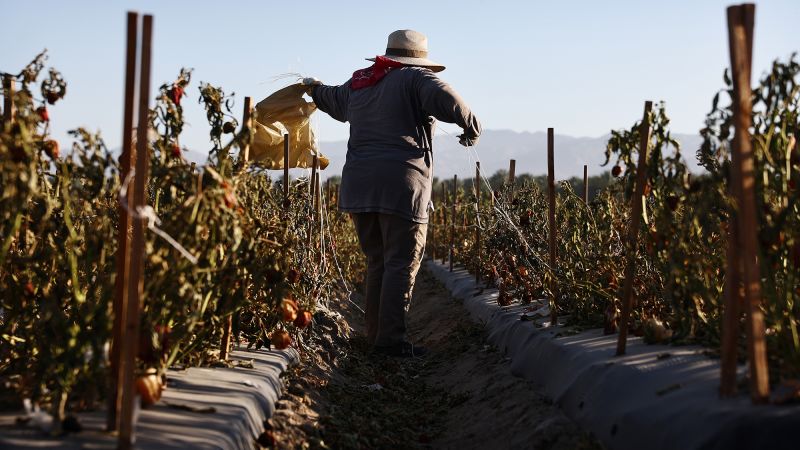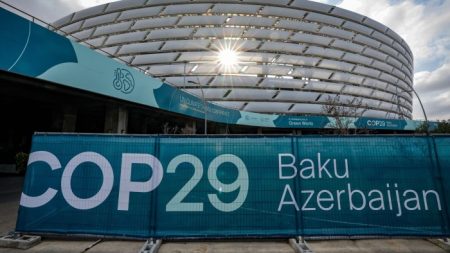While inflation in the US has been cooling since hitting a four-decade high, the temperature outside continues to climb.
It’s been one of the hottest summers on record for much of the country and the planet, which last week experienced the hottest day in recorded history.
But US consumers aren’t only taking a financial hit from this summer’s extreme heat by way of their electricity bills. Shoppers could soon have to pay much higher prices for fruit and vegetables as farmers shoulder higher growing costs from the heat, a reversal of a trend seen over the past year with the cost of fruits and vegetables dropping by 1%, according to June Consumer Price Index data.
Tom Avinelis, who owns organic farms that grow blueberries and citrus fruits around Fresno, California, and the Willamette Valley in Oregon, said near-record-breaking heat waves this month with temperatures upwards of 100 degrees in both areas has caused more fruit than usual to shrivel, resulting in less harvestable produce.
“It decreases a lot of our revenue potential,” said Avinelis, whose produce is managed by Homegrown Organic Farms, which sells nationwide in stores such as Whole Foods, Trader Joe’s, Costco and Safeway.
For the rest of this summer, consumers aren’t likely to see markedly higher prices for seasonal fruits like blueberries because contracts with distributors and retailers tend to be worked out in advance, he said.
“But, as we see more and more of these heat events, it will challenge production and change the supply and demand dynamics,” Avinelis, who has been in the agriculture business for over 40 years, told CNN. That’s why in the next few years, he said, the prices consumers pay will be higher to be more reflective of the expenses farmers like him are incurring to adapt to more extreme heat, such as installing upgraded irrigation systems.
Yet despite those upgrades, he says he is still at a disadvantage compared to nonorganic farmers who can use the plant equivalent of sunscreen on citrus trees to shield them from some heat.
Even corn, one of the top-produced crops in the US with most states growing it, is suffering steep losses from heat.
A 2021 study published by the Atlantic Council found that corn growers in the US are losing “$720 million in revenue annually due to heat’s effect on crop yields, which will increase to a projected $1.7 billion annually by 2030.”
“The consequences of this could include farm closures and higher prices for food and livestock feed,” the study notes.
Researchers from the University of Waterloo in Ontario, Canada, and Mohamed bin Zayed University of Artificial Intelligence in Abu Dhabi estimated that temperatures three degrees above historic averages have a significant chance of reducing strawberry yields by as much as 40%. Their recently published analysis drew from publicly available data on strawberry yields in Santa Maria, California, from 2011 to 2019 and monthly temperature averages there from 1991 to 2021.
One of the researchers, Kumaraswamy Ponnambalam, who teaches systems design engineering at the University of Waterloo, told CNN the project launched because a supermarket chain in Canada reached out to his team in search of software to help them better predict the prices they’ll pay for the produce they sell to customers. Ponnambalam said his team chose to focus on strawberries because the supermarket told him they are the most challenging type of produce to forecast pricing for, especially as an importer.
As Ponnambalam and his team helped design software for them, they suspected there was a correlation between temperature and crop yields, prompting their separate, more in-depth analysis.
Ponnambalam and his coauthors said their findings can be used to help “guide farmers and policymakers in implementing effective climate change adaptation strategies in strawberry production and potentially in other high-value agricultural crops.”
Henry Gordon-Smith, the CEO and founder of Agritecture, an agriculture consulting and advisory firm that specializes in climate change planning, said many growers he works with have maintained the same output as past years, but it’s “come at a significantly higher cost.”
“Increased water usage, additional labor for monitoring and managing heat stress, and investments in protective measures like shade cloths all contribute to higher production costs,” he told CNN. “Despite these efforts, in some cases, the output is still lower, and the quality of the produce can be compromised.”
Ultimately, the effects of climate change have caused an increasing number of farmers to shift their operations entirely indoors, said Gordon-Smith, who recently taught a course titled “Smart Agriculture for a Changing Climate” at Columbia University.
Having an environment where farmers can control environmental factors such as temperature and humidity, and other environmental factors helps “to mitigate the adverse effects of heat waves,” he said. However, the steep costs to make that switch could also contribute to higher prices consumers pay for produce.
For farmers who aren’t able to or may not be willing to shift to indoor growing, Gordon-Smith’s strategy to help them survive heat waves involves using sensors and artificial intelligence tools to track weather and make predictions that guide their decisions.
“The challenges posed by extreme heat underscore the urgent need for adaptive strategies in agriculture,” he said.
Read the full article here













